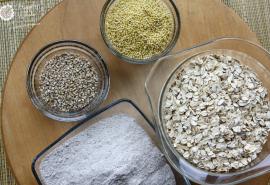
What is ‘real food’ anyways? It seems like an arbitrary term that has been swept up by the internet food industry. Real food is anything we eat, right? And it’s safe to assume what we purchase as food is real, right? Seems logical and, well, ethical. But…
WRONG
You see, food has been hijacked by industry making it more and more fake all the time! In fact, so much of what we consume from packages comes from non-nutritive sources that we’ve become accustomed to ingesting ingredients we can’t even pronounce let alone define. And, I hate to say it, but the reasons for re-inventing our foods for manufacturing and mass production have not proven healthy for our human bodies. But, I suppose industry forcing real food into processed states does provide some positives:
~Longer shelf life
~Cheaper options
~Mass production
~More flavors
~Convenience
As you can see, the positive aspects of processing foods does not translate to enhancing our personal health or preventing illness. It’s a shame really!
But, with a little awareness and education, there’s hope to clean up our kitchens and consume a diet filled with REAL, nourishing foods! It’s really about getting back to the basics and simplifying what we eat. I like to call it ‘eating close to the earth’. A while back, I had my own ‘real food revelation’ and it felt life ‘real food relief’!
It’s like taking a deep breath and exhaling all the complication we’ve caved in to from manufacturer’s marketing, diet ploys and food fads.
It’s about simplifying the sources of our nourishment and using nature to flavor our foods. Now, THAT sounds appealing!
Ove the next several weeks, I am going to be spending some time sharing hints and tips about how to clean out your kitchens, make some easy swaps in your fridge and pantry, how I fill my grocery cart with real foods to please my family and what I do to keep us eating clean around here. Much of this will come in the form of short videos and tutorials for Happily Whole Members….hint, hint! Now’s a good time to get on board if you’ve ever considered it! Here's a recent video post I did on this very topic: Real Food for Real Families (become a Member here: Membership)
But, before we can begin, I want us to get on the same page with what real foods really are. As you’ll see, it’s not only plant based! Although I have gravitated towards a plant-based style of eating, I have recently made some adjustments. Read more about my PLANT BASED philosophy here: Real Food Revelation. Read more about my adjustments here: Meat in my Meals:
- Grass-Fed, Pastured Meats: Meaning animals that have been raised and fed as they were intended when created, with grass underneath and the sun overhead. This includes chicken, beef, lamb, pork, and wild game that have NOT been pressed, processed or bombarded with preservatives, antibiotics or growth hormones.
- Eggs: From chickens that have been pastured, roaming free with lots of sunlight. Eggs are one of my 'go to' protein sources. I even include them in this list: Real Foods I Can't Live Without
- Fats: Such as: butter from grass-fed cows, unrefined coconut oil, ghee, extra virgin olive oil, tallow, and even lard (NOT Crisco). I also adore wild fish, raw nuts and seeds and avocados for good fats. Here's a favorite granola bar filled with raw nuts and seeds: Granola Bars

- Grains and Legumes: Whole grains, beans, nuts, and seeds. Avoid refined grains and pasteurized nuts and seeds because the heating processes kills nutrients and enzymes. If you can’t tolerate grains, grain-free flour substitutes also called ‘pseudo-grains’ (almond flour, coconut flour, etc.) may be used for baking.
- Fruits and Veggies: Preferably in-season, organic and/or locally-grown, if possible. Including lots of fresh herbs. I eat tons of dark green veggies in my morning smoothie, salads and cooked in evening meals. I like to tell people to ‘eat a rainbow’ of fruits and veggies every day if possible! That way, you’ll consume all the different colors of nutrients available.
- Dairy: Raw when possible (or pasteurized) and full-fat from grass-fed cows (or goats or sheep). Anytime you see the words low-fat or fat-free you know a lot of junk has been added to make up for the nourishing fats. This would include: milk, cheese, sour cream, yogurt, kefir, cream cheese, cottage cheese. Avoid ultra-pasteurized dairy.
- Salt: Real, unrefined salt that hasn’t been stripped of its nourishing minerals. I use Real Salt or Pink Himalayan salt.
- Seafood: Fish raised in the wild versus a fish farm. I especially love wild, fresh salmon. Here's one yummy salmon recipe: Salmon and Brussels Sprouts

- Sweeteners: As close to the natural state as possible, such as raw honey (local honey is always preferable due to its health benefits), pure maple syrup, and natural sugars (sucanat and coconut sugar). Here’s more information I’ve provided about sugar: The Not So Sweet Side of Sugar
I hope this list helps you to start thinking about how to go about eating a real, clean repertoire of food. Give your body a break and nourish it with what God provided us with in nature!
Stay tuned for more on this topic. This is the year of getting back to the basics and nourishing your body, mind and spirit naturally.





Comments